I’m A Grad Student: How can I buy good wine?
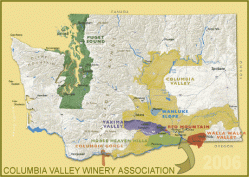
After one of my recent posts, my good friend and graduate student, Jon French (he’s a third year architecture student at the Univ. of Washington) asked me if I could post something about how a poor grad student like himself could learn about affordable wine. As much as he enjoys reading about my exploits, he knows that on his budget, he’s not going to be diving into a 15 year old Bordeaux any time soon (unless he’s in the neighborhood, of course). I promised him that my next post would cover the subject so here goes.
Let’s use poor Jon as an example. First, Jon’s a distant cousin of Allie Smith, wife of my favorite east coast wine-maker, Brian Smith of Oyster River Wine Growers, in Warren, Maine. Allie and Jon grew up spending parts of their summers together on Pond Island, a little piece of heaven off the coast of eastern Maine. Brian’s wines are inexpensive and Jon occasionally passes near-by on his way to Pond Island or to Breezy Point, another slice of paradise near Belfast, Maine. Jon should stop in and see his cousin; She’d give him a family discount for sure. 🙂
Jon lives in Washington State, home of the Columbia River Valley and other locales that harbor some of the best vineyards and winemakers in the country. Jon needs to join a couple of friends, throw his bike into the back of a pick-up, and depart the Seattle smog for wine country some Saturday afternoon. My guess is that three things will happen; i) they’ll stumble across some fabulous vineyards and taste some amazing wine, much of it for free. ii) they’ll find some very good wine for sale for very reasonable prices – $10 a bottle is easily obtainable, and iii) they’ll forget about grad school for awhile and have a great time, all the while getting exercise riding their bikes from one vineyard to another.
Jon can start by doing a little research on the local vineyards, for example by checking out the Columbia River Valley Wineries here. Among the numerous vineyards to be found there, the region is home to Columbia Crest in Paterson. Columbia Crest makes to a wide variety of wines, a few of which are very expensive cuvees meant to be cellered for awhile. Others are sold into the market for so-called premium wines that represent the core of the country’s wine market. I know Jon has had lots of Columbia Crest wine over the years; what he hasn’t done is sit down with six or eight glasses of wine from the same vineyard and get to taste each of them, looking both for their similarities and differences. This is how a person really learns about wine and it’s why Jon needs to get out into rural Washington State while he can. After all, eventually he’s going to graduate and move someplace else – like Sweden or Norway (his style of architecture would be appreciated in Scandanavia).
Seattle is also close to the many wonderful wines of the Willamette Valley and other regions in Oregon. Salem, home to St. Innocent, is only a few hours away and well worth the drive. In addition to sampling some of the single vineyard Pinot Noirs there, Jon could get a great deal on a couple of bottles of their Village Cuvee (2009-$24). St. Innocent is only one of the many vineyards in Oregon that attempt to make several wines and sell them at several price points. When Jon sits down with someone special to open a bottle he found on one of his visits to a local vineyard the opportunity to drink something he brought home from such a trip will make the entire evening that much more pleasurable.
One thing that interests and fascinates me about the wine business is that there are now many places in the US where you can go into the countryside and find local farmers growing grapes and making wine. Not all of their products are world-class but much of it is affordable and the fun someone can have making the trip is well worth the effort.
So get out there and find some local wine; you owe it to yourself.
Happy New Year to all!
May all of you enjoy the best of life in 2011.
2000 Chateau Gloria
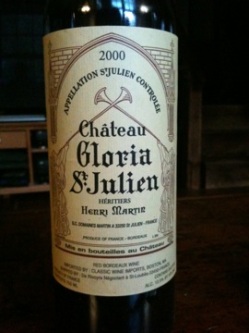
Broke out a bottle of 2000 Chateau Gloria this week and enjoyed it along with one of Pam’s great stews. The wine is an excellent example of St. Julien from Bordeaux and wonderfully smooth and velvety. I have about 10 bottles of this wine left so there’s lots more to enjoy over the years.
Port for Christmas

In our house, an open bottle of vintage port has been a Christmas tradition since the mid 1980s. And this year is no exception.
Pam was out last night, singing as part of the Portsmouth based choral group, ConTutti, and after spending over a half an hour trying to find a parking spot somewhere in downtown Portsmouth so that I could go to the annual ConTutti Christmas concert, I gave up and headed home.
It seemed like a good time to open up the Christmas port and since it’s just the two of us this year, I grabbed a split of 1994 Taylor Fladgate Vintage Port, bottled in 1996. Sigh! It’s going to be a great Christmas.
15 years ago, I subscribed to Wine Spectator, one of the major wine industry rags that caters to both the industry and to its customers. Much of my knowledge about the industry, the world-wide localities where wine is made, and wine, to the extent that you can learn about wine by reading about it, came from the pages if Wine Spectator; I must admit that if you’re interested in really learning about wine, subscribing for several years to the magazine, either on paper or on-line, is a great way to do so. Anyway, in 1996, Wine Spectator rated the 94 Taylor Fladgate, along with wine from its sister vineyard, Fonseca 100 points – perfection. Both winemakers are located in the heart of the Douro Valley, the wine-making district in Portugal, not far from the the coastal city of Oporto, the place where Port got its name.
To quote James Suckling’s words that I read in Wine Spectator in April of 1997, shortly after the wine was released to the market, “in a word, superb. It’s full-bodied, moderately sweet and incredibly tannic, but there’s amazing finesse and refinement to the texture, not to mention fabulous, concentrated aromas of raspberries, violets and other flowers…..”. Now here we are almost 13 years later and the wine is coming into it’s own (this powerful example of a great port will last for 100 years or more). The good news is that the tannins are beginning to subside – whole chunks were left in the bottle when I decanted it last night – but the incredible concentration of flowers and fruit hit like a freight train when you breath in the aroma of the wine and run you over when it arrives in your mouth. And it seems to last forever……..
I drank only a little last night, perhaps an ounce. I’m going to do everything to make it last until New Year’s Eve.
St. Innocent Winery
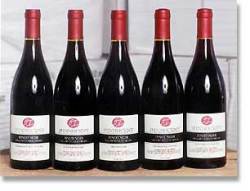
A couple of years ago, when Amelia was in her first year of graduate school at the University of Washington School of Information Sciences in Seattle, we rented a home on Bainbridge Island for a week at Christmas. It was our first real introduction to the Pacific Northwest and we spent a memorable week exploring the coastal communities and trtying out the best that Seattle had to offer. Kate flew in from Alaska, Amelia’s boyfriend, Jon, and his parents, along with our great friends, the Scotts, all joined us on the island for Christmas dinner and it almost felt like home.
Somewhere along the line, one of us bought a Pinot Noir from St. Innocent Winery, in Oregon. The wine turned out to be the beverage hit of the trip and before we left, we stopped into, Delaurenti’s, a small wine merchant near Pike Place Market downtown and picked up a bottle of Justice 2006 – the same bottling and vintage we’d been lucky enough to try, and I tucked it into a travel bag to bring home. Only, like an idiot I made an attempt to carry the bag on the plane, and needless to say it was confiscated. Unfortunately, I couldn’t even get the TSA folks to share it; they were prohibited from doing so – and it ended up in the garbage.
Anyway, several weeks ago, we took delivery of our 2008 allocation – when we returned home from Seattle, I promptly went on-line and pre-ordered a mixed case of the 2008s. Boy am I glad we did.
We opened a bottle of the Justice 2008 last weekend and while our choice of a meal to have it with was found wanting (turkey leftovers, good on their own but not up to a great pinot noir), the wine was a mouthful. Now this wine is very different from most american Pinot. For one thing it’s basically indistinguishable from a good burgundy. I’m not saying it’s a Romanee Conti, but the wine is well structured with loads of raspberries mixed with plum and other berry flavors. The level of concentration is up there with many of the solid Burgundies from some of my favorite winemakers such as Jean Marc Pavelot, Paul Guaradet and Rene Engel – the wonderful folks who modernized Burgundy and made affordable Pinot Noir wines from small shares of vineyards in places like Volney, Savigny les Baunes, Vosne Romanee and Gevrey-Chambertin in the 1990s (don’t try to acquire their better offerings in a good vintage today without $100+ to spend).
And best of all, most of St. Innocent’s wine is affordable – especially if you live close by and can get it straight from the winery without having to pay for shipping. The wine has made it to the east coast as well. My favorite wine merchant in New England, Kenny Kirk at Action Wine and Spirits, has managed to find some from time to time so ask around.
Sea Smoke
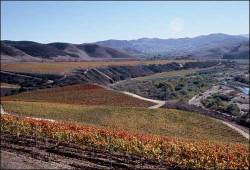
Four years ago Pam and I spent New Years Eve at the Hancock Inn in Hancock, NH, a lovely and rural inn and restaurant that advertises itself as the longest continuously operating inn in the country. That night, besides having a wonderful and romantic evening, lingering over a delicious dinner across from a roaring fire, our inn-keeper host, Robert Short, introduced us to Sea Smoke Cellars in Santa Barbara, CA, and their wonderful Pinot Noir wines.
Last night when I arrived home from work I found a case of Sea Smoke’s 2008 wines waiting for me; it’s been a long time coming. Shortly after we returned from Hancock, I searched out the Sea Smoke website and added my name to the mailing list, only to be disappointed when I received a response several hours later indicating that the annual allocation of wines to mailing list members was long sold-out and that it could be years before we would make it to the allocation list. So I bookmarked the website and promptly forgot about the whole thing….. until a couple of months ago when I received another email indicating that after four years I had finally made it to the allocation list and I should make sure that my contact information was up-to-date. It seems that the recession has had one positive impact, clearing lots of folks off the sold-out allocation lists of various vineyards around the country.
I think it’s safe to say, I could hardly wait to open the wine and get a taste of what memory told me was a wine for the ages. For someone who enjoys good French Burgundy, it’s hard to imagine that it’s possible to find a great Pinot Noir outside of that illustrious appellation. But I’m here to tell you now that you can. We opened our first bottle from the mixed case, a 2008 Southing, to accompany a simple dinner of fresh lemon dover sole along with steamed Zuccinni. Pam took the first sip and exclaimed “it’s full of caramal!” My first taste was of the insides of cherry pie, with hints of cinnamon and clove. Over dinner, as the wine opened up, the fruit never diminished but the tannins began to show themselves, giving a long finish and hinting at a wine that will continue to age for years to come.
This wine represents to me what American winegrowers and winemakers are capable of when it comes to Pinot Noir. I have to admit that I’ve never tasted a Burgundy that comes close to this particular taste, so it’s not fair to to really compare say a 2001 Georges Compte de Vogue Chambolle-Musigny Burgundy with SeaSmoke Southing 2008; each has its place. But it’s clear, great American Pinot Noir has arrived.
The Brunellos of Tuscany
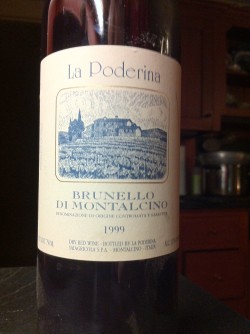
I first tasted a Brunello di Montalcino in 1996, visiting with a friend in Boston when he took me to a local trattoria for a drink. The wine, a 1985 Poggio Antico Reserva, overpowered me and left me with a sense that I had just discovered Italian Sangiovese for the first time. Of course we’ve all being drinking Sangiovese since college (it’s the principal grape found in Chianti, a staple of the college dating scene for as long as we all remember). Who can forget taking that special someone to a small Italian restaurant with the red checkered table-clothes and basket-covered wine bottles with the glowing candles on the table providing the romantic cover that set the evening in the right direction. For me, that restaurant was Dino’s on Plantation Street in Worcester, where I attended college.
Shortly after my first taste, I laid down my first case of Brunello; a mix of 89 and 90 Poggio Antico that I found at my favorite wine merchant in Shirley, Ma. Brunello quickly became our favorite wine to have when Pam gets adventurous in the kitchen with pasta and tomatoes. Over the years we’ve put down and gone through cases of Castello Banfi, La Poderina, Poggio Antico and several others. The wine has been uniformly full-bodied with lots of intense fruit, silky tannins (after a few years of aging) and interesting hints of leather, smoke and tobacco. Of course, I’ve paid attention to the vintages and selected wines with appropriate structure but I’ve been lucky. All of the Brunello we’ve laid down has been wonderful.
Anyway, last night I got home early from work and Pam offered to make pasta with some locally produced hot sausage she’d found along with fresh pasta and locally grown tomatoes. I headed down to the cellar and found what turned out to be our last bottle of 1999 La Poderina, a wonderful Brunello that once got 96 points from Wine Spectator. Now, if you follow the link, you’ll find a lot opinions about this wine but it likely comes down to how well the wine has been stored. This bottle was close to perfect. As Brunellos go, this one is on the light side – not quite full-bodied but still lots of intense fruit flavor, hints of leather (due to it’s age) and tannins that would keep this wine aging nicely for at least another 5 years, if not a decade.
The only problem with Brunello is the price. Typically, you’ll spend $50 or more per bottle for the good stuff (Brunello is typically aged on the lees for 3 years before release) and the reserve wines (released a year after the regular bottling) can go to $100 or more. In order to afford these wines, I pull out all the stops. I buy by the case to get the 20% case discount, I look for sales, and whenever possible, I’ll share a case with someone. If memory serves me, I shared the case of La Poderina with my niece’s husband, Vince. I hope he and Erica have enjoyed their share of the case as much as we have.
Le Gouleyant – Cahors Malbec at the Blue Moon in Exeter
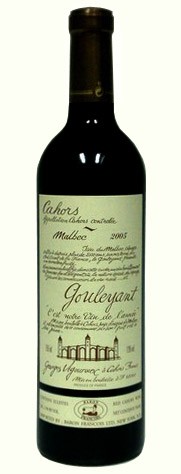
Pam and have just found our new favorite restaurant where we can go for a quiet dinner after I get home from work!
For several years Pam’s been part of the yoga community centered out of the Blue Moon Cafe and Market, in Exeter, NH. Kathy Gallant and her family have been operating the establishment since 1995 and have built a community of folks who appreciate wholesome, locally grown organic food and related merchandise that they’ve turned into great meals in the cafe and for take-out. The Blue Moon yoga studio upstairs, headed up by Julie Roost and focused on the theory and practice of classic yoga, has also attracted a wonderfully diverse group of locals who share their passion for the contemplative arts together. Recently, however, in a bid to re-focus and get the energy to keep the community together, Kathy changed directions and opened a full service restaurant that maintains the original philosophy but really steps up the menu, with the expert assistance of chef Matt Grecco, service, and ambiance into a first-rate operation ready to compete with all the wonderful restaurants in the seacoast region. Check out Seacoast Online for a great review of the restaurant.
Anyway, I met Pam after work last Tuesday for dinner and I’m afraid our monthly entertainment bill just went up. We had a delicious dinner that incorporated lots of locally grown organic produce as well as the best available seafood – a few meat dishes are also available although the vegetarian will find the largest selection.
After a beautifully put-together salad, I had a main course that included wild Alaskan salmon lightly grilled in a flavorful seasoning. Just perfect. Pam’s main course was a feta stuffed tortelacci covered with a tasty fennel sauce; I can still taste the flavors. We finished the meal by splitting a to-die-for pumpkin panna cotta with a pumpkin cookie on the side – lightly seasoned with a hint of sweet.
The surprise of the evening, however, was the wine. While the wine list is fairly basic and reasonably priced, it’s clear that Kathy’s daughter, Alissa, who took on the task of putting the list together seriously, did so with care. There’s no Turning Leaf on this list! While I’ve tried and enjoyed a number of the wines on the list, the one that immediately caught my attention was the Le Gouleyant, a Malbec (well, 80% anyway, the rest is Merlot) from Cahors.
First, a word about Cahors, a small wine region (appellation) in the southwest of France next door to it’s more famous neighbor, Bordeaux. They’ve been growing grapes and making wines in Cahors for 2,000 years so the vignerons know something of their craft. For many years however, the winegrowers of Cahors focused on growing the highest quantity of grapes possible on the river floodplain while ignoring the nearby hills where wine growing got it’s start in the region (farming on the valley floor was originally limited to food crops, of course). Fortunately, in the mid 80s the locals began to find themselves shut out of the wider French market as wine quality improved throughout the country. By the early nineties, a new generation of winemakers began to take over their family farms and set about to re-create the Malbec wines of the past by planting new vineyards on the hillsides, dramatically reducing yields and focusing on organic growing methods – and then applying modern methods to their winemaking. The result is truly astonishing as the simple and austere wines of their fathers have given way to world-class wines with the concentration and complexity expected of a competitive wine.
The only problem with Cahors Malbec wines is their rarity. I’ve been reading about these wines for years (even read a book about the winemakers of Cahors last year) and until this week, I’d never tasted one. So there was no question that we would try the Le Gouleyant, a wine made by Georges Vigouroux, one of Cahors leading winemakers.
Now, the interesting thing here is that since Cahors is not well known in this country, the region’s wines are a true bargain. What few Malbecs from region you can find will set you back as little as $10, although of course that doesn’t include the restaurant markup which can run between 200-300%, depending on the restaurant. So all that said, what was the wine like?
In two words, I was simply amazed. The Argentinians have set a high bar for Malbec, so that’s what I have to compare the Le Gouleyant to. The good news is that Cahors is back. The wine was dense, complex and full of fruit with cherries, blackberries and raspberries in abundance. The wine we were drinking was likely a 2008 (we were drinking by the glass – it was mid-week after all), so it showed it’s youth but this is a wine that is balanced and it has just the right amounts of tannins to see it through another 10 years, no problem.
And best of all, the New Hampshire State Liquor Store has it available for $179.00 per case.
In Venge Veritas
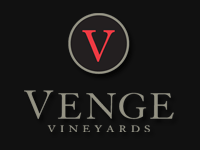
I mentioned in an earlier post my trip with oldest daughter Kate to northern California three years ago in order to attend the wedding of Kate’s college roommate, Elieza. After the wedding, Kate and I left Santa Cruz and drove north to Napa Valley and spent two days touring the valley and visiting lots of vineyards. The highlight of the trip to Napa was our discovery of Venge Vineyards, a small producer of world-class Cabernet Sauvignon and Syrah wines.
We finished our first day of touring at Rutherford Hill Vineyards, a well known vineyard just up the road from Auberge du Soleil. Auberge du Soleil is a wonderful four star restaurant and part of the Relais et Chateaux chain, where we had dinner reservations (another story). While at Rutherford Hill, we got to talking with the salesman in the wine tasting room – it was the end of the day and the crowds had left – and after agreeing to purchase several wines, including the first true Port style wine I’ve ever even considered acquiring from some place other than the Douro Valley in Portugal, the salesman told us about Kirk Venge and Venge Vineyards up the road a ways on the Silverado Trail, and how his wife had just started working in the Venge tasting room with some incredible wines. He ended up calling his wife, Lin Forino (Venge’s Hospitality Manager), on her cell phone and made us an appointment for 10:30 the next morning.
We arrived at Venge the next morning, “modestly” hung-over after an incredible evening at Auberge du Soleil and wishing for another 2 or 3 hours sleep. It was a beautiful morning and the parking lot was empty with the exception of the family dog, who met us enthusiastically. Lin met us at the door and, noticing our condition, immediately offered us some fresh coffee and a plate of local cheese and fruit. I was sold on the place before we even got to the wine.
Lin explained the history of the Venge family and Kirk’s father who has been making wine in the valley for more than four decades; he’s currently the proprietor of Saddleback Vineyards, a small winery a short drive away. Then she brought out the wines.
After trying a number of different cuvees, our favorite turned out to be the 2005 Gladys’ Vineyards Syrah; a deeply concentrated mouthful of pepper, fruit and berries that reminded me a lot of the best of Gigondas (one of the southern Rhone’s most powerful village co-operative wines and, like most Rhones, typically a mix of Syrah, Grenache and Cinsault), only better. We got to try the 2005 Family Reserve Cab but it was clearly out of our price range at that point so we passed on acquiring any.
Once we finished our tasting and made arrangements to have a case of the Syrah shipped to New Hampshire, we were fortunate to have Kirk Venge, the tour de force wine maker responsible for everything we were falling in love with, walk into the tasting room and introduce himself to us. Kirk was kind enough to offer us a tour of the winery. I should note that the winery has since moved to a new location several miles away and I haven’t had a chance to see it yet but what I saw of the original winery was impressive enough.
Kirk uses traditional methods, lots of french oak and organically grown grapes – along with modern equipment – to produce world-class age-worthy red wines that I’m slowly filling my cellar with. I’ve had a chance to taste several vintages of a number of Kurt’s wines including the Family Reserve Cabernet Sauvignon, the Scout’s Honor Zin, several vintages of two different Syrahs, Gladys’ and Muhlner Steps, and two other wines including a delicious white called Champs des Fleurs. I can’t wait to receive my first bottle of Silencieux, a new Cabernet that will be released from the new winery for the first time this week.
Kirk’s wines are well recognized. For example, his 2007 Family Reserve was awarded 98 points by Robert Parker – a classic rating – and while I no longer pay much attention to wine ratings, preferring instead to make my own selections, I have to agree that this wine deserves very point it received.
Kate and I left Venge feeling like we found our own personal wine-maker. We’ve since gotten to know all the staff at the vineyard and routinely buy their wines on release. Now Napa is a long way from New Hampshire but Lin and Kirk treat us like next door neighbors and Kate shares in my passion for the Venges and their wine. As a matter of fact, I had them ship a bottles of the Gladys to her in Alaska this week as a special gift.
Napa Cabernet and Columbus Day Weekend
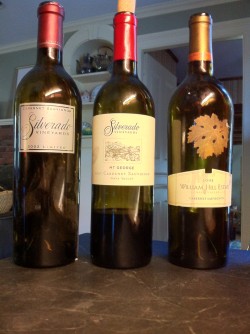
Our daughter, Kate, returned home to New Hampshire this weekend from her own home outside of Anchorage, Alaska for the first time in 3 years and needless to say its a cause for celebration. Both my daughters, Kate and Amelia, have been on the west coast for the past few years – although Amelia recently graduated from UW graduate school and found job nearby in Massachusetts – so it’s been wonderful having them here together, even if it’s only for a few days.
Kate and I attended her college roommate’s wedding together in Santa Cruz three summers ago and while we were there, we took the opportunity to tour Napa Valley together for a couple of days, visiting and sipping our way through about 20 vineyards and wineries. Two that we visited were Silverado Vineyards – one of Napa’s leading producers of premium Cabernet Sauvignon wines – and a smaller, less well known winery nearby, the William Hill Estate Winery, on Atlas Peak Road, just off the Silverado Trail.
I had known about and had opportunities to try wines from both wineries over the years and come to enjoy them both. In particular, I cellared a case of 1991 Silverado Reserve Cabernet Sauvignon (still have a couple of bottles left down there and they’ve aged perfectly). My brother, who’s wine cellar is limited to few bottles he’s collected over the years, has likely the last bottle to be found of William Hill 1982 Cabernet; a cabernet for the ages that was, I believe, William Hill’s first ever release of the wine.
I spent the last a couple of days on the Cape with by brother, Bruce, visiting my mom who lives in a nursing home there, and enjoying my brother’s company. Bruce originally acquired his 1982 William Hill from Bruce Gibson, the proprietor of Harwich Spirits Shoppe in Harwichport and the two Bruces have been close friends ever since. As a matter of fact, my brother had recently heard from the shop that there were located 10 cases of 2005 William Hill and on the odd chance that Bruce (my brother) wanted any, we should stop by and taste it. So we did just that and bought a the bottle that was opened for us to try – I’ll buy some more on my next visit to the cape but didn’t have time to do so yesterday.
We bought wines from both wineries while we were there and had them shipped back to us in NH. I found the 2005 William Hill Cabernet to be totally closed in and didn’t buy any; boy was that a mistake. I did purhase a couple of other wines there, however – another story. At Silverado, I signed up for their newsletter and managed to get an annual allocation of some of their better wine – I think I have about 4 cases of their wine in the cellar right now.
So back to our daughter’s visit. Last night, Amelia prepared a wonderful roasted Chicken and Rosemary dinner while got to wander around the cellar for awhile. We ended up with two Silverados (2002 Limited and 2007 Mt George) along with the open bottle of William Hill 2005.
Now it goes without saying that all three bottles were fine examples of well crafted Napa Cabernet. The 2002 Silverado Limited is coming into its own and showed tons of fruit with nice structure and enough silky tannins to indicate that there’s lots of years left in the wine. The William Hill was a baby, however. Although the bottle had been open 24 hours previously and clearly was fully aerated, and although it too is nicely balanced with a mouthfuls of black cherries and currants, the wine needs at least 5 more years before it will come into its own without requiring 24 hours of airing out before serving.
The surprise of the evening was the Silverado 2007 Mt. George. While it too was young and in need of additional aging, the wine had a level of complexity rarely found in reasonably priced wine. As this wine gets older, my guess is that it will become something special.
So there you have it; my whole family together, great wine and an entire evening to enjoy. We finished up with the last glass of wine, enjoying Bach Cello concertos. What an evening.
